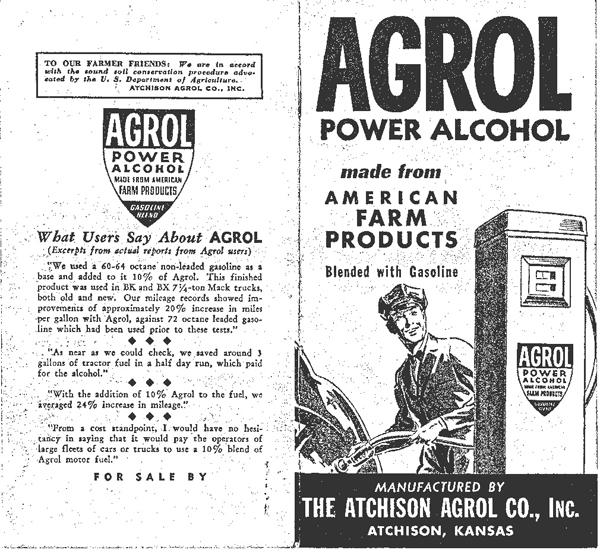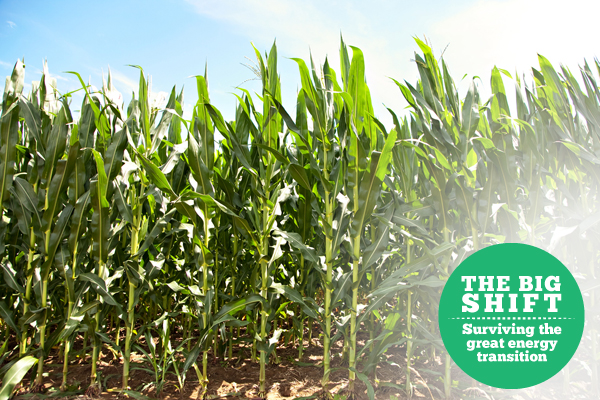In 1917 Alexander Graham Bell, Canada's premier inventor, had a bold ethanol vision. He predicted, in the pages of the National Geographic no less, that alcohol-based fuels would power the future when petroleum ran out.
Corn alcohol "makes a beautiful, clean and efficient fuel," declared Bell. "We need never fear the exhaustion of our present fuel supplies so long as we can produce a crop."
Well, Mr. Bell wasn't alone in thinking that corn stalks and other biomass might dominate future energy supplies. Rudolf Diesel ran his engine on peanut oil and Henry Ford once championed gasoline made from sumac fruit and weeds as a way to reanimate rural economies.
Harry Ricardo, the British genius who designed the Rolls Royce engine, even thought that alternative vegetable-based fuels were superior to mineral based ones.
"By the use of a fuel derived from vegetation, mankind is adapting the sun's heat to the development of motive power, as it becomes available from day to day; by using mineral fuels, he is consuming a legacy -- and a limited legacy at that -- of heat stored away many thousands of years ago."
But the power alcohol business, perhaps one of the oldest forms of alternative energy, is now mired in food versus fuel debates and the poor quality of its energy returns.
Given the number of firms that have gone bankrupt in recent years, it also looks like another stalled vehicle on the world's renewable energy freeway.
Although production has grown swiftly in the last decade from 600,000 barrels to 1.6 million barrels a day, it still accounts for less than two per cent of the world's global liquid fuel supply. The heavily subsidized industry's impact on food prices, biodiversity, water supplies and climate change has also come under intense scrutiny.
Tea Party activists, environmentalists and petrolistas now condemn the industry in equal measure. And visions of running vehicles or energy slaves on cellulose, algae or sea kelp-based fuels remain just that: uncommercial visions.
But Bill Kovarik doesn't think we should write the industry off yet. In fact, researchers claim that as much as 30 per cent of the world's transportation fuels could eventually come not from food crops but from engineered energy plants (such as Agave, mesquite and switch grass) designed to produce more fermentable sugars for biofuels. They could also be grown on marginal lands or in the ocean.
"Biological energy sources are the way to go," says Kovarik, "but ethanol production is awkward in terms of energy inputs and it needs to change. We need to transition to the next generation fuel crops."
Nor does Kovarik think we should dismiss a largely agricultural movement that has challenged the abusive power of Big Oil (a veritable transportation fuel monopoly) for decades.
Corn-based ethanol, after all, finally forced leaded gasoline, a known public health hazard, off the market in the 1970s. But the fuel additive could have prevented the adoption of lead gasoline in the first place -- something Big Oil actively thwarted.
Snake oil and moonshine
Kovarik, a 61-year-old energy historian and journalism professor at Radford University in southwestern Virginia, not only hails from moonshine country but also has studied the ups and downs of the alcohol energy business for decades.
In addition to being one of the co-authors of The Forbidden Fuel: A History of Power Alcohol and other books, he's also made legal moonshine. (Kovarik is also an environmentalist whose fascinating blog notes that the killing of environmental leaders has increased from 11 in 2009 to 28 last year.)
Kovarik first got interested on biofuels back in 1978 while working for famed U.S. muckraker and newspaper columnist Jack Anderson. "Anderson hated the oil industry. He thought it was underhanded and conniving and he thought that anything that challenged the power of the Big Oil was good."
After meeting a group of protesting farmers who powered their tractors with biofuels, Kovarik got hooked on the subject. While other reporters laughed at rural folks who energized their machinery with "moonshine," Kovarik recognized a unique energy story with two dramatic polar themes.
On the one hand biofuels offer a promising replacement for dirty fossil fuels, and on the other they compete with food production.
It is also an ancient story. Vegetable oils, animal fats and turpentine from wood dominated the use of fuels for cooking and illumination in human households until the 19th century. But this growing demand for plants or biomass destroyed forests, impoverished soils and diminished biodiversity especially in Europe.
Then along came the U.S. oil boom in the 1870s. After the Civil War, the U.S. government put a tax on turpentine made from southern pines. In so doing it inadvertently made tax-free kerosene distilled from Pennsylvania oil the popular choice for cooking and illumination. A massive government subsidy set oil off on a path of market dominance. explains Kovarik.
"All energy is political and snake oil comes in kinds of guises," adds the historian.
Henry Ford feared peak oil
Although the first combustion engines ran on ethyl alcohol and turpentine, gasoline soon dominated the booming combustion engine industry too. But concerns about the longevity of petroleum supplies worried luminaries such as Alexander Bell and Henry Ford, writes Kovarik in his 2012 short history of biofuels.
Nor surprisingly, oil-poor European nations such as France and German first developed biofuels on a large commercial scale.
To counter the monopolistic practices of Standard Oil, Germany built a large potato alcohol market in the 1900s. The industry powered tractors, hair irons, heaters, stoves and even coffee roasters. The French did the same with sugar beets.
As many as 30 countries supported some kind of ethanol blending program for gasoline including Brazil, Cuba and the Philippines. Most of the fuel came from sugarcane plantations.
In India, the agrarian Kanaiyalal Manekial Munshi advocated using farm waste for biofuels instead of crops or seeds due to concerns about famine and food prices.
Meanwhile, crop-based fuels squarely challenged mineral-based gasoline even in the U.S., the world's first petro state. A U.S. auto industry representative, for example, told a U.S. Senate committee that crop-based alcohol was "preferable" to and cleaner than gasoline.
In fact, some 2,000 engine fuel studies between 1905 and 1907 by a variety of government offices including the U.S. Navy concluded that a gallon of ethanol burned more cleanly than a gallon of gasoline.
But in the 1920s and 1930s, Big Oil took on the emerging biofuels industry with a vengeance. While farmers viewed ethanol as a way to replace critical grain and hay markets killed by the demise of horse transport, Big Oil viewed the agrarian movement as intolerable competition.
Prominent biofuel advocates even included car magnate Henry Ford. The Michigan farm boy envisaged a decentralized energy system producing fuel, fibre and chemicals in rural areas. In contrast, Big Oil offered highly centralized and concentrating technologies.
Other supporters argued that crop-based fuels could revolutionize agricultural economics, reduce city smog, end rural migration to cities and weaken Big Oil's grip on the government and the economy.
Knock, knock
At the same time, the car industry had a big problem with engine knocking due to low octane gasolines. Chemists offered two distinct solutions. One involved blending gasoline with ethanol at high percentages. The other and cheaper solution consisted of mixing gasoline with small volumes of refinery additives such as lead or later MTBE, a water pollutant.
Standard Oil (now Exxon Mobil) backed the lead solution as the only engine knock alternative, despite widespread public health studies on the metal's toxicity to the brain. The industry also suppressed studies that clearly showed that ethanol safely solved the problem, says Kovarik.
Due to its extensive investments in lead gasoline additives, Standard Oil also vilified a populist farm movement to produce Agrol, an ethanol/gasoline blend that sold at 2,000 service stations in the U.S. Midwest in the 1930s.
"To force the use of alcohol in motor fuel would be to make every filling station and gasoline pump a potential speakeasy," thundered one report by the National Petroleum Association.
As a consequence the U.S. ethanol industry -- it uses corn grown to feed livestock -- didn't take off until the ban on leaded gasoline in the 1970s and the world's first oil price shocks. The highly subsidized industry now diverts 40 per cent of U.S. corn production to ethanol distillers and cost taxpayers about $6 billion a year.
It also accounts for serious amounts of soil erosion; nitrate run-off into the Gulf of Mexico; and increased food costs as well as feed costs for livestock. The majority of ethanol, in turn, fuels inefficient machines that actually convert less than 20 per cent of heat generated by the fuel into mechanical energy.
The industry has also grown a field of loud critics. They describe farm-based alcohols as schemes to rob taxpayers or to take food from the poor to make fuels for the rich. They also challenge the energy returns, which are dismally low.
In other words, it takes almost as much fossil-based energy to grow, fertilize, water, harvest and distill crop-based fuels as they return in the form of bio-energy.
Algae, seaweed and cellulose
In recent years, scientists have switched their focus from crops and seeds to cellulose, the plant kingdom's most common building material. Cellulose is a strong sugar polymer that builds stalks, stems, trunks and blades.
Armed with enzymes, fungus and microorganisms, scientists promised a cellulostic ethanol revolution that would produce 500 million gallons of fuel a year by 2012. Yet the industry has barely managed 20,069 commercial gallons. Making hydrocarbons from carbohydrates, it turns out, is not for the faint of heart.

Nearly six years ago Amyris, a biotech firm, vowed, for example, to make renewable diesel and jet fuel by feeding Brazilian sugar to microorganisms. But they couldn't replicate large lab yields in real commercial operations.
"Humbled by the lessons we learned," as one executive put it, Amyris now makes moisturizers for cosmetics. Other firms such as Cello and Range Fuels have gone bankrupt. Last year Shell and Ottawa-based Iogen killed a plan to build a cellulose ethanol plant in Manitoba. High corn prices, due to drought and high oil prices, have idled one-third of Nebraska's ethanol plants. And so on.
"It turns out the cellulose technology is difficult and multi-staged and it's like pharmaceuticals," explains Kovarik. "It's expensive to provide cheap oils."
Research on algae-based fuels has encountered similar hurdles. Although algae grows fast, sequesters carbon and produces a good oil, it currently costs anywhere between $300 and $2,400 to make one barrel of fuel.
One 2010 study concluded that squeezing oil from engineered algae faced a myriad of challenges including "strain isolation, nutrient sourcing and utilization, production management, harvesting, co-product development, fuel extraction, refining and residual biomass utilization."
Plans to farm sea kelp or common sea weed, which grows faster than most land-based crops, also offer some promise adds Kovarik.
But sea kelp plantations would require an ocean area the size of Argentina just to replace fossil fuels used for global transportation needs.
As one U.S. federal study politely noted, "the dedication of a large area of open ocean surface for a single commercial purpose is unprecedented."
Innovators wanted
Kovarik thinks that biofuels on some scale will eventually find their place in the scheme of things. But he is disturbed that the only real energy transition now taking place is the growing shift from lighter to heavier petroleum crudes made from 300-million-year-old plants. All come with large carbon, water and environmental footprints. Many, such as bitumen produced by steam plants, have energy returns on par with biofuels.
"We need to re-envision a more equitable world where we make and use energy differently in communities," he says.
He doesn't think government is spending enough money on renewable energy research, let alone innovative technologies. History shows that the energy market can't be left to its devices, because it has no foresight and offers nothing but a race to the bottom.
Society also seems to be ignoring "the larger problem of how we are going to replace petroleum in the international economy over the long term."
And so the historian and communication specialist poses a difficult question:
Why is the social construction of energy technology so much more difficult than the social construction of, say, computing and the digital media revolution?
"Was IBM that much less of a challenge than Standard Oil? Where are the Steve Wozniaks of the energy revolution?"
He doesn't have an answer yet. ![]()
Read more: Energy, Labour + Industry, Environment


















Tyee Commenting Guidelines
Comments that violate guidelines risk being deleted, and violations may result in a temporary or permanent user ban. Maintain the spirit of good conversation to stay in the discussion.
*Please note The Tyee is not a forum for spreading misinformation about COVID-19, denying its existence or minimizing its risk to public health.
Do:
Do not: